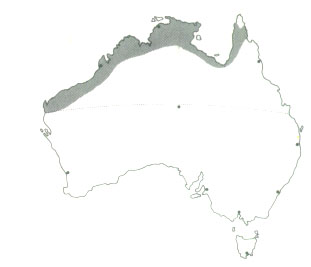![]()
 |
 |
DISTRIBUTION: Restricted to rushes and tall grasses around creeks and swamps in northern Australia. Uncommon in southern parts of range, especially in settled areas. |
Star Finches. Male is the topmost Bird. |
Distribution Map |
|
IDENTIFICATION. LENGTH = 120 mm MALE: Upper parts yellow-olive; upper tail-coverts dull scarlet with white spots; tail dull brown-scarlet. Front part of head crimson; face and chin crimson with white spots. Underparts yellow-olive spotted white with centre of belly yellow. Eye red-olive; bill scarlet; legs yellow. FEMALE: Duller than male with less crimson on head and face. IMMATURES: Upper parts olive-brown; underparts pale olive; head and face grey.
|
NESTING. Breeds December-August, mainly March-April. Nest rounded to bottle-shaped with no entrance tunnel; 110 mm long, 90 mm high and 130 mm wide, of either coarse green or dried grass, lined with wool and feathers; placed in small bushes and trees. Eggs: three to six; pure white; 15 X 11 mm.
|
|
FORMS.
|
|
AVIARY BREEDING. NESTING TYPES: I have found that these birds will nest almost anywhere although they will usually prefer a nest box including parrot nest boxes rather than build a nest of their own. I have seen these birds build nests in tea tree branches and planted trees but very rarely. Best results have been from boxes 150 mm square X 125 mm high with a 40 mm access hole in the front and a small landing platform just below the entrance. (See the Plans page for more information) FEEDING: A general finch mix is ideal for this bird. Birds will also readily take seeding grasses and live food. However I have had seen these birds breed successfully with just a mixed seed diet. Egg and biscuit will also be taken readily. OTHER FEEDS: Cuttlebone and shell grit should be supplied at all times. SPECIAL REQUIREMENTS: There are no special requirements for this species. However care should be taken not to house this species with the Masked Finch or the Long-tailed Finch or any of the subspecies.
|
| AVIARY SPECIFICATIONS. | WIRE MESH: 1/4 x 1/4 or 6 mm x 6 mm | Also known as mouse wire |
| LENGTH: 11ft 6in or 3575 mm | WIDTH:6ft or 1800 mm | HEIGHT: 8ft or 2400 mm |
| SHED: Half the aviary should be enclosed.
These are recommendations only and individual breeders may have different dimensions and specifications.
|
FLOOR: I have found a dirt floor preferable. |
OTHER: |
|
BREEDER SUBMISSIONS. |
|
| From |
![]()
Author
P Campbell
Copyright © 2002 P. Campbell. All rights reserved.
Revised: April 23, 2002
.